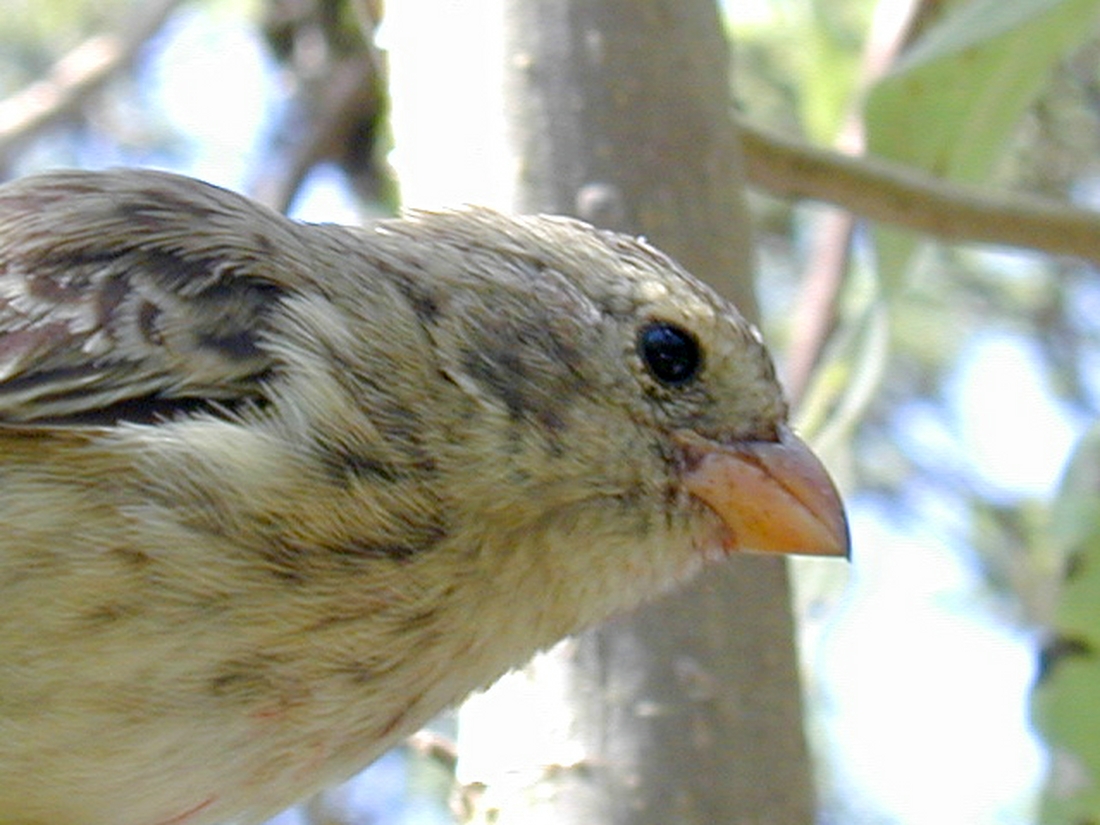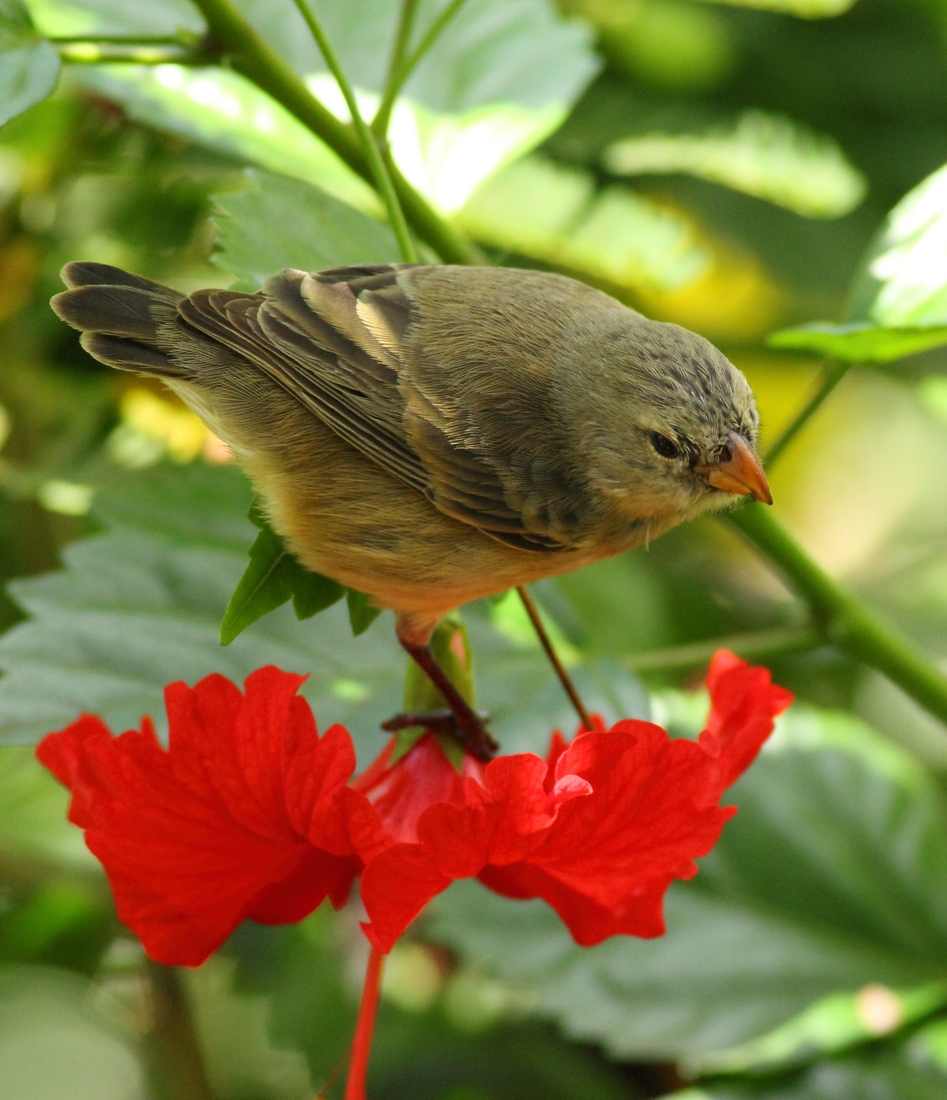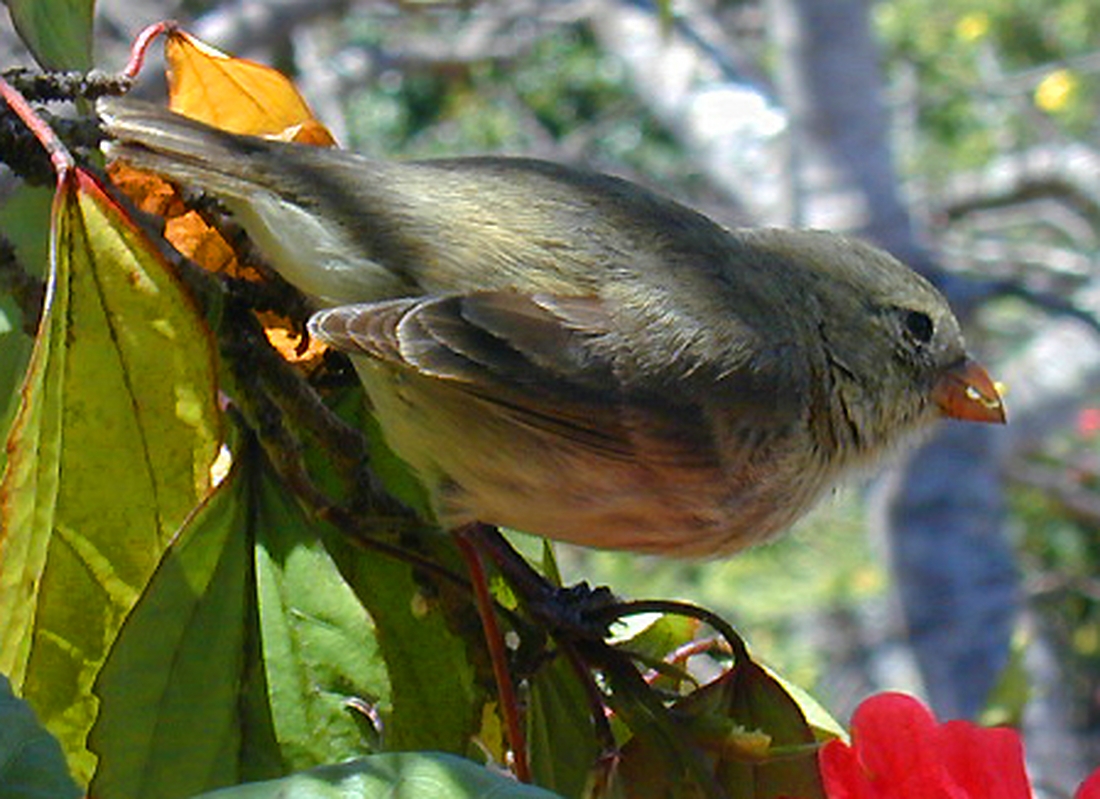Galapagos Species Database
The Galapagos Species Database shares the information about the species from our Natural History Collections.
Camarhynchus parvulus
Pinzón de árbol pequeño, Pinzón arboreo pequeño, Small Tree Finch





Smallest of the Darwin tree finches, 13 gr average, same as small ground finch. Short conical beak. Males develop a black hood with age, starting with face and head, while upper parts are olive green and underparts creamy. Males in San Cristóbal hardly ever have black plumage, but upper breast is heavily streaked. Females and young males have green-olive upper parts and creamy to yellowish underparts.
Threats Known to be affected by the parasitic fly Philornis downsi that causes heavy chick mortality. Recent studies showed very low breeding success that may cause long term population collapse.
Domain
Eukaryota
Kingdom
Animalia
Phylum
Chordata
Class
Aves
Order
Passeriformes
Family
Thraupidae
Genus
Camarhynchus
Species
parvulus
Taxon category: Accepted
Syn.: Camarhynchus parvulus parvulus (Gould 1837); Camarhynchus parvulus salvini Ridgway 1894; Geospiza parvulus (Gould, 1837); Camarhynchus prosthemelas (Schlater & Salvin, 1870).
Taxon origin: Endemic
Habitat preferences: Found in forests both in the humid and more arid transition zones.
Trophic role: Omnivorous
Reproduction mode: Exclusively sexual
Reproductive biology: Male displays in front of a dome shape nest high up in the canopy. Once chosen, the pair either use this nest or build a new one. Only females incubate (two to three eggs), both feed the chicks. Fledglings stay for up to 6 weeks with a parent, either with the male while the female starts a new clutch, or, one with the female and the other with the male.
Map of specimen collection localities or observation records for this species in our collections database.
Distribution: Found on Isabela, Fernandina, Santa Cruz, Santiago, San Cristobal, Floreana, Baltra, Santa Fe, Pinzon y Rabida. Has been seen on Pinta but it is not known if there isa breeding population there. Found mostly in the highlands and the transitional zone.
- Wiedenfeld, D.A. (2006) Aves, the Galapagos Islands, Ecuador. Check List 2006 2(2): 1-27.
- Jiménez-Uzcátegui, G. Milstead, B., Márquez, C., Zabala, J., Buitrón, P., Llerena, A., et al. (2007) Galapagos vertebrates: endangered status and conservation actions. Galapagos Report 2006–2007. Charles Darwin Foundation, Puerto Ayora, p. 104–110.
- Harris, M.P. (1973) The Galápagos avifauna. Condor 75(3): 265-278.
- Salvin, O. (1876) On the avifauna of the Galápagos Archipelago. Transactions of the Zoological Society of London 9: 447-510.
- Sundevall, C.J. (1871) On birds from the Galápagos Islands. Proceedings of the Zoological Society of London 1871: 124-129.
- Fessl, B. Tebbich, S. (2002) Philornis downsi - a recently discovered parasite on the Galápagos archipelago - a threat to Darwin's finches? Ibis 144: 445-451.
- McQuistion, T.E. Wilson, M. (1988) Four new species of Isospora from the small tree finch (Camarhynchus parvulus) from the Galapagos Islands. Journal of Protozoology 35(1): 98-99.
- Swarth, H.S. (1931) The Avifauna of the Galapagos Islands. Occ. Pap. Calif. Acad. Sci. 18: 1-299.
- Fessl, B. Couri, M.S. & Tebbich, S. (2001) Philornis downsi Dodge & Aitken, new to the Galapagos Islands (Diptera, Muscidae). Studia Dipterologic 8: 317-322.
- Kleindorfer, S. Dudaniec, R.Y. (2006) Increasing prevalence of avian poxvirus in Darwin’s finches and its effect on male pairing success. Journal of Avian Biology 37: 69-76.
- Jiménez-Uzcátegui, G. Betancourt, F. (2008) Avifauna vs automotores. Informe Galápagos 2007-2008. FCD, PNG & INGALA. Puerto Ayora, Ecuador. p. 111–114.
- Lincango, M.P. Causton, C.E., Calderón-Álvarez, C. & Jiménez-Uzcátegui, G. (2011) Evaluating the safety of Rodolia cardinalis to two species of Galapagos finch: Camarhynchus parvulus and Geospiza fuliginosa. Biological control 56: 145-149. http://dx.doi.org/10.1016/j.biocontrol.2010.10.006
- Bisconti, M. Landini, W., Bianucci, G., Cantalamessa, G., Carnevale, G. Ragaini, L. & Valleri, G. (2001) Biogeographic relationships of the Galapagos terrestrial biota: parsimony analyses of endemicity based on reptiles, land birds and Scalesia land plants. J. Biogeogr. 28: 495-510.
- Donohue, K. (2011) Darwin's Finches: Readings in the Evolution of a Scientific Paradigm University of Chicago Press, Chicago, 492 pp.
- Guerrero, A. Tye, A. (2009) Darwin's Finches as seed predators and dispersers. The Wilson Journal Of Ornithology 121 (4):752-764, 2009
- Dvorak, M. Fessl, B., Nemeth, E., Kleindorfer, S.M., & Tebbich, S. (2012) Distribution and abundance of Darwin ́s Finches and other land birds on Santa Cruz Island Galapagos: evidence for declining populations. Oryx 46:78-86
- Tebbich, S. Taborsky, M., Fessl, B., Dvorak, M. & Winkler, H. (2004) Feeding behavior of four arboreal Darwin's finches: adaptations to spatial and seasonal variability. The Condor 106:95-105
- Zylberberg, M. Lee, K., Klasing, K. & Wikelski, M. (2012) Increasing avian pox prevalence varies by species, and with immune function, in Galápagos finches. Biological Conservation 153:72-79.
- Cimadom, A. Ulloa, A., Meidl, P., Zöttl, M., Zöttl, E., Fessl, B., Nemeth, E., Dvorak, M., Cunninghame, F. & Tebbich, S. (2014) Invasive parasites, habitat change and heavy rainfall reduce breeding success in Darwin’s Finches. Plos One 9:e107518.
- Christensen, R. Kleindorfer, S. (2009) Bill Morphology Does Not Influence Vocal Performance in Darwin’s Small Tree Finch on Floreana Island. Zoological Research 33:423-428.
- Christensen, R. Kleindorfer, S. (2007) Assortative pairing and divergent evolution in Darwin’s Small Tree Finch, Camarhynchus parvulus. Journal of Ornithology 148:463-470.
- Christensen, R. Kleindorfer, S. & Robertson, J. (2006) Song is a reliable signal of bill morphology in Darwin's small tree finch Camarhynchus parvulus, and vocal performance predicts male pairing success. Journal of Avian Biology 37:617-624.
- Christensen, R. Robertson, J. & Kleindorfer, S. (2010) Male response to intruders is related to song characteristics in Darwin’s small tree finch (Camarhynchus parvulus). Journal of Ethology 28:371-377.
- Christensen, R. Kleindorfer, S. (2009) Jack-of-all-trades or master of one? Variation in foraging specialisation across years in Darwin’s Tree Finches (Camarhynchus spp.). Journal of Ornithology 150:383-391.
- Kleindorfer, S. Dudaniec, R. (2009) Love thy neighbour? Social nesting pattern, host mass and nest size affect ectoparasite intensity in Darwin’s tree finches. Behavioral Ecology and Sociobiology 63:731-739.
- Kleindorfer, S. O’Connor, J., Dudaniec, R., Myers, S., Robertson, J. & Sulloway, F. (2014) Species collapse via hybridization in Darwin’s Tree Finches. The American Naturalist 183: 325-341
- Kleindorfer, S. Sulloway, F. & O’Connor, J. (2009) Mixed species nesting associations in Darwin’s tree finches: nesting pattern predicts predation outcome. Biological Journal of the Linnean Society 98:313-324.
- O'Connor, J. Sulloway, F. & Kleindorfer, S. (2010) Avian population survey in the Floreana highlands: Is Darwin’s Medium Tree Finch declining in remnant patches of Scalesia forest? Bird Conservation International 20:1-11.
- O'Connor, J. Sulloway, F. & Kleindorfer, S. (2010) Avian population survey in the Floreana highlands: Is Darwin’s Medium Tree Finch declining in remnant patches of Scalesia forest?. Bird Conservation International 20:1-11.
- Farrington, H. Lawson, L., Clark, C. & Petren, K. (2014) The evolutionary history of Darwin's finches: speciation, gene flow, and introgression in a fragmented landscape. Evolution doi 10.1111/evo.12484.
- IUCN (2015) The IUCN Red List of Threatened Species. Version 2015-4. <www.iucnredlist.org>. Downloaded on 20 November 2015.
- Lamichhaney, S. Berglund, J., Sällman Almén, M., Maqbool, K., Grabherr, M., Martinez-Barrio, A., Promerova, M., Rubin, C.J., Wang, C., Zamani, N., Grant, B.R., Grant, P.R., Webster, M.T., Andersson, L. (2015) Evolution of Darwin’s finches and their beaks revealed by genome sequencing Nature 518: 371-386. doi:10.1038/nature14181
- Remsen, J.V. Areta, J.I.Jr., Cadena, C.D., Claramunt, S., Jaramillo, A., Pacheco, J.F., Pérez-Emán, J., Robbins, M.B., Stiles, F.G., Stotz, D.F., Zimmer, K. J. (2016) A Classification of the Bird Species of South America. South American Classification Committee. American Ornithologists' Union http://www.museum.lsu.edu/~Remsen/SACCBaseline.htm
- IUCN (2017) The IUCN Red List of Threatened Species Version 2016-3. <www.iucnredlist.org>. Downloaded on 03 February 2017.
- Freile, J.F. Santander, T., Jiménez-Uzcátegui, G., Carrasco, L., Cisneros-Heredia, D., Guevara, E., Sánchez-Nivicela, M., Tinoco, B. (2019) Lista Roja de las aves del Ecuador Quito, Ecuador. 97 pp.
- GBIF Secretariat (2021) GBIF Backbone Taxonomy. Https://doi.org/10.15468/39omei Accessed via https://www.gbif.org/species/5284517



Feeding type: Polyphagous
Approx. 50% of diet comprises insects and larvae foraged mainly from trees and moss above ground level although they do occasionally forage on the ground. The other half of their diet comprises fruits, seeds, young leaves, flowers and nectar. There is variation in the diet between the humid and arid zones, and between seasons (more fruit is eaten in the dry season).